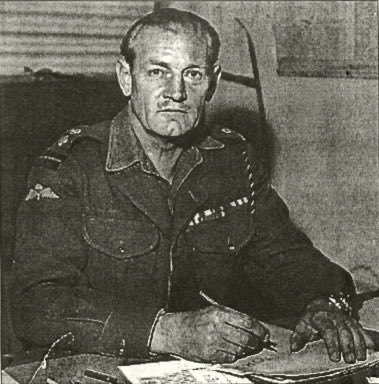
- The Man Who Fought in WWII with a Sword and a Bow 🧵 -
Born into an old Oxfordshire family, Jack Churchill graduated from the Royal Military Academy at Sandhurst in 1926 #Svagaiature #WWII #History #Scotland #Trivia (1/16)
Born into an old Oxfordshire family, Jack Churchill graduated from the Royal Military Academy at Sandhurst in 1926 #Svagaiature #WWII #History #Scotland #Trivia (1/16)

In 1930 he left the Army and worked as an editor of a Nairobi newspaper, a model, and a movie extra, he even participated to the 1939 bow World Championship representing Britain (2/16) 

In 1940 Jack felt the call of duty and re-joined the Army becoming the second in command of an infantry platoon. Everything fine, if it wasn’t for the fact that Mad Jack always marched into battle with bow, arrows and his trusty basket-hilted claymore by his side (3/16)
To those questioning his weapons choice he always replied: “In my opinion…any officer who goes into action without his sword is improperly dressed.” But those weren’t just accessories or decorations (4/16)
During the 1940 Battle of Dunkirk Churchill struck down a German soldier with a well-placed arrow. He was later seen chugging along on a motorcycle with his bow strapped to the side. A German officer’s cap was hanging on the headlight (5/16) 

But he also knew how to keep the morale high in the old fashioned way. During operation Archery he stood at the front of the landing-craft playing his bagpipes to the tune of “The March of the Cameron Men.” When they landed, he charged with his sword in hand. (6/16) 

During his time on the Italian front Jack became famous when one night during an operation he went ahead of his men charging the enemy’s sentries that frightened by the sword wielding demon surrendered one by one. That nigh Jack captured 42 men by himself (7/16)
When asked about this story he always said: “I maintain that, as long as you tell a German loudly and clearly what to do, if you are senior to him he will cry ‘jawohl’ (yes sir) and get on with it enthusiastically and efficiently whatever the situation” (8/16) 

In 1944 in Yugoslavia his unit was surrounded and outnumbered facing certain defeat Mad Jack did what any sensible soldier would have done… he played his bagpipes - “Will Ye No Come Back Again” this time - until he was knocked unconscious by German grenades and captured (9/16)
Churchill was placed in Sachsenhausen concentration camp after being interrogated. The Germans had believed that he was some sort of relative of Winston Churchill, which wasn’t the case, but he was still considered a “prominent” prisoner due to his rank. (10/16) 

As you might expect, Mad Jack wasn’t one to be kept in a prison camp. He made a run for it that September by sneaking through an old drain under the barbed wire. He and a comrade were recaptured not long after and moved to a camp in Austria. (11/16)
In April 1945, the Austrian camp’s lighting system failed. Churchill took advantage of the opportunity walking away from his work detail. He simply kept walking, and eight days and 150 miles later, he ran into a U.S. convoy in Italy and was returned to safety. (12/16)
As you can imagine he was disappointed to learn that the war was winding down and that he had missed a year of it. Rather than return home, he got himself assigned to Burma where the war against Japan was still in full swing. (13/16)
By the time he got over there, though, the bombs had been dropped on Nagasaki and Hiroshima, meaning that the war was basically over. An unhappy Churchill vented, “If it wasn’t for those damn Yanks, we could have kept the war going for another 10 years!” (14/16)
The end of the war didn’t mean the end of Churchill’s adventures, though. He decided to train as a parachutist, and when he qualified, he was sent into Palestine as the second-in-command of the 1st Battalion (15/16)
He later became a land-air warfare instructor in Australia, where he developed a love of surfing. He ended up retiring from the army in 1959 and died in 1996 in Surrey. (16/16)
• • •
Missing some Tweet in this thread? You can try to
force a refresh















